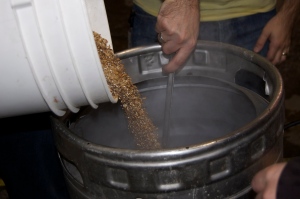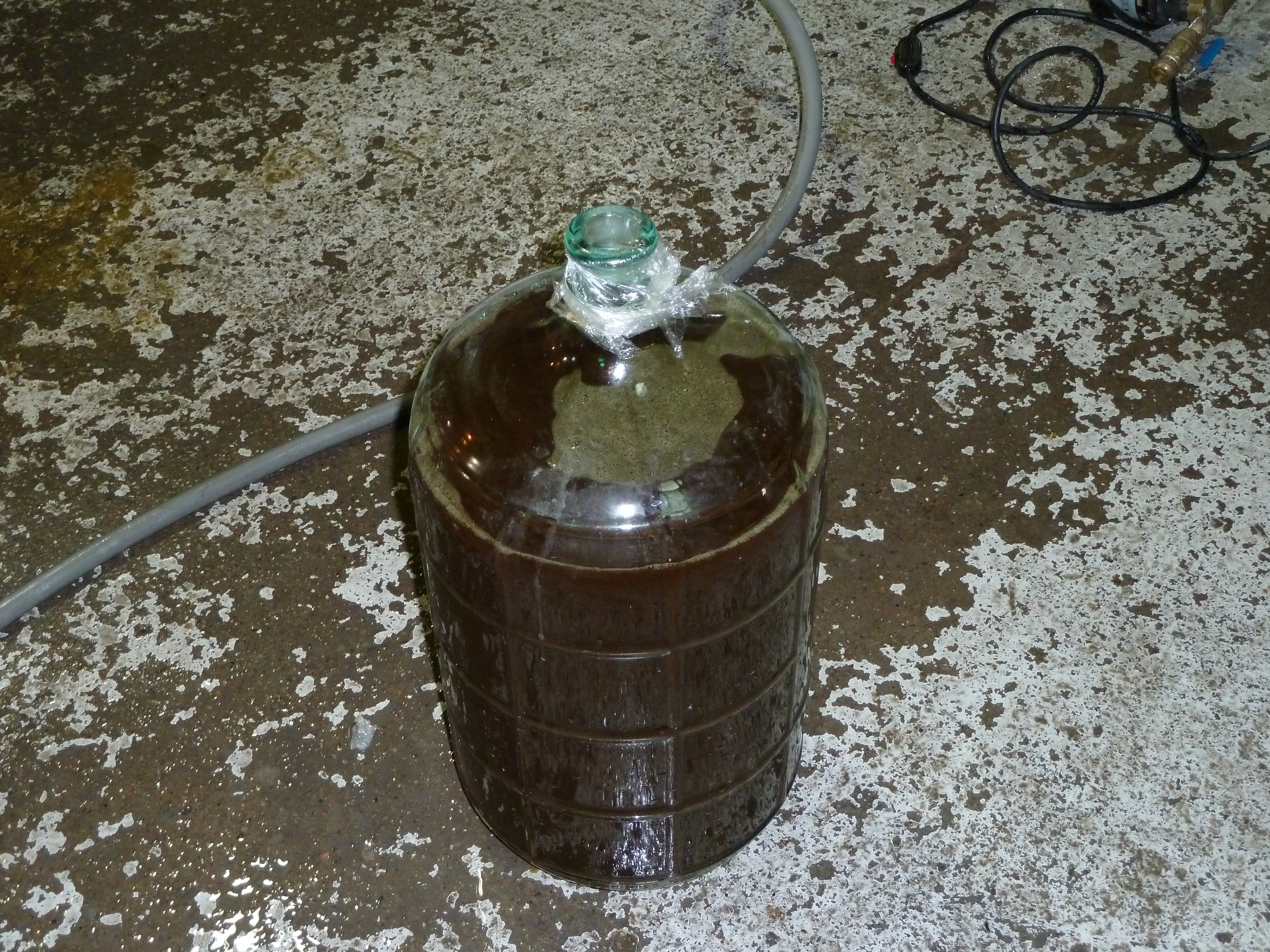In the run up to the brew day at Amsterdam, I was pretty nervous. You never know exactly how something like your first all-grain brew day is going to go. There are a lot of considerations: Is my recipe any good? What goes on at an event like this? Does this ridiculous moustache make me look like a hobbyist or a walrus?
It was for this reason that I showed up early. I was told that the doors would open at Nine AM and I was shocked to discover that there were already people on the ground with their setups basically ready to go. I thought that I saw a couple of stations where people had already started their water heating when I got there. The rest of my team trickled in over the next hour or so.
We ran into a number of problems almost immediately. Not only did it take us the better part of a half hour to figure out how the equipment we had been provided fit together, our ingredients didn’t arrive. The guy from Homebrewers Retail had apparently had a number of late orders and had to load everything into his van, which was then promptly encased in traffic.
This was a good opportunity to avail ourselves of the donuts and coffee provided and walk around looking at the other homebrewers practicing their craft. You may not credit it, but it reminded more me of a grade seven science fair than anything else. All of the brewers have come up with slightly different techniques for what they’re doing. There were grain mills powered by electric drills, Coleman coolers that had been converted into mash tuns, and one station had come up with an ingenious method of mashing in the brewing kettle using a mesh bag to lift the spent grain out of the wort. It’s a very clever idea, but I feel like any system that requires the use of a pulley is more complicated than it needs to be. I may have been imagining it, but I swear that the same station had a grain mill powered by a foot pump a la a 1950’s Singer sewing machine.
This is one of the great things about homebrewing: no one does it in exactly the same manner. There’s no bog standard kit. It results in foil wrapped mash tuns and kettles and Rube Goldberg style apparatus. It appeals to the same part of the male brain that convinces a hapless newbie that he can rebuild a carburetor, or that it is patently necessary to replace the pickups on a Telecaster with gold plated Humbuckers and that it’s probably only an afternoon’s work.
We stood around patiently, waiting for the supplies to arrive, venturing upstairs to look at the memorabilia. The Amsterdam staff were clearly getting nervous about the fact our supplies hadn’t arrived. At one point they offered us the carte blanche use of whatever grains they had on hand in storage so that we could get started. I think this was only partially motivated by their desire to get home at a reasonable hour.
At about 12:30 our grains and hops arrived and we swung into action, borrowing milling equipment from a nearby station. We actually ended up borrowing equipment from just about everyone within 50 feet, since none of us had brought any useful tools. Here is a picture of Chris Schryer getting way, way too into grinding grains.
One type of grain that we wanted, Carastan, was out of stock at the time of my order so in order to make up the difference, Andrew Bartle hit the Amsterdam loft and raided their supply of grains. It was very much a handful here and a handful there. I think there may have been some smoked malt in the mix that he came back with. It smelled great. Unfortunately, the quantities that he selected mean that if we accidentally come up with something really good it’s pretty much completely unrepeatable.
I won’t go particularly in depth on the brewing process here for the very simple reason that there are not a lot of interesting things that I can say about heating water to 158 degrees farenheit (dull!) or how to poke holes in tinfoil in order to ensure that clarification occurs during the sparging process (carefully!). I will tell you a couple of things that made me pretty proud of my team selection, though:
I had no idea that Matt Caldwell was this good a photographer. Look at this picture of grain falling out of the bucket we were using as a hopper. Clearly he has some skills that I didn’t know about.
Another thing that impressed me was this: Clearly, as bloggers we talk a lot about things that we like and things that are available. In this setting I think we all started out at the beginning of the brewing session with a lot of apprehension. We have all read so much about beer over the years that it sort of came creeping back in during the brew day. Concepts that we’d only read about suddenly became a lot clearer. As soon as you start applying theoretical knowledge it starts to make sense in a way that it simply can’t otherwise. I mean, it’s all well and good to suggest that you know what sparging is and it’s great to understand the process of using a counterflow chiller for wort cooling, but until you actually muck in, it’s mostly jargon.
Since the beer we were brewing had a lot of cinnamon aroma, we got a lot of foot traffic over the course of the day. Much of the foot traffic, I suspect because of the aroma, was female. Cinnamon apparently has the same wafting effect as a cartoon pie on a windowsill. We posed periodically for photo ops or had to explain exactly what it was we were doing and the great thing is this: We were not just making stuff up in order to look like we knew what we were doing in front of girls. I was explaining starch conversion in a way that made me realize I have absorbed more about this subject than I thought. Chris Schryer actually had people tasting raw specialty grains so that they could understand what each grain was contributing to the flavour of the beer. What a good idea!
At the end, after we managed to get it into the carboy we had this Christmas Ale ready to go. Bartle pitched the yeast the next day and I understand that somewhere in the depths of the Amsterdam facility our experiment is bubbling away, forming a krausen and a colony of yeast is having a wonderful time. It only remains to be seen what we’ll do with it.



Pingback: So You Want To Be a Brewer – Learn 2 Brew at The Amsterdam Brewery « St. John's Wort
Pingback: SOB? Yeah You Know Me! « One Beer at a Time
Pingback: Beer Launches and The Christmas Ramble « St. John's Wort
Pingback: Fast Forward (Christmas Ale) – Beer #310 « One Beer at a Time